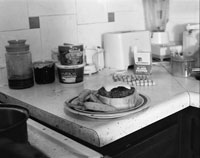Although Greater New York takes up the entirety of the recently further-folded-in PS1 at MoMA, the crowd at Thursday’s preview reception stayed mostly outdoors, lounging on the steps like students of New York’s contemporary art during a recess break. The quintennial show of emerging artists from the metropolitan area features 68 artists and artist collectives, has an air of optimism, both in the work and in the feeling of the artists who lingered near it. Artists seemed unanimously happy with the installation a real rarity. The show had been preceded by the speculation endemic to New York, and young artists, the who’s in and who’s out, which curator of the three curators (Klaus Biesenbach, Neville Wakefield, Connie Butler) did which studio visit, etc. But summer approaches and the economy is looking up, so the memo is to buck up. Meanwhile, the art world is awash with blood that’s both fresh and thoroughly enmeshed in the community of of its forebears. Greater New York compels one, as participating artist Conrad Ventur so elegantly stated, “to stop feeling like shit and start to feel good.”
That doesn’t necessarily amount to a clean break from the past. Inside the galleries, everywhere were the trappings of the technologically outmoded: the clicking of 16-mm projectors; the indexical traces of gelatin silver transfers; the sweet tones of “Back to Life” by Soul II Soul that played on repeat in the room that housed the Greater New York 5 Year Review, a scrapbook showcase dedicated to the to most important cultural events in the last half decade as determined by the a group of curators and critics. On the second floor, Naama Tsabar’s Mixed Media Sculptures with Bookshelf invited spectators to approach the twin large-scale sculptures, which faced each other like sound barriers outfitted on their flank sides with an the trappings of an electric guitar on steroids, and strum on them, shooting reverb through the gallery. Next door, Michele Abeles waited in a corner in front of her photographs, She explained her work to me until her boyfriend, writer Domenick Ammirati, approached, and in the spirit of collaboration, she deferred to him, insisting she was only repeating his words lifted from the catalog. He denied the claim, although he did admit to possibly coining a phrase or two. Behind every woman …. Speaking of which, who will be the first to tally the participating artists by gender? It was easy to find the artists, as many stood watchful in front of their installations like proud young inventors at a science fair.
On the top floor, an eloquent LaToya Ruby Frazier talked me through her analog photographs, a series that documents the political, environmental and personal climate of her hometown, Braddock, Pennsylvania. The black-and-white works refer to previous masters of the industrial wasteland, like Walker Evans, although her landscapes are personal and chart the terrain of her life and that of her family. They mourn the decay of the culture that pre existed gentrification and revitalization, capturing what Frazier calls the “erasure of history” in her subject matter and process. “It’s important to think about how digital technology is driving people away from traditions such as the gelatin silver print and I feel the need to play the revisionist,” she says. No time like the present. Next door, a collage of four-by-six-inch color photographs by Deana Lawson diffused in the corner of the gallery, spreading eerily and rather biologically up the walls. The piece combines images from pop culture and reference war, the family, and the perversions of society. Together, the photographs take our frenetic browsing on the Internet and flatten it, lay it out before our eyes. If Frazier’s work is involved with the outmoded, then Lawson’s is a la mode, referencing a time when images are endlessly globbed together in a non sequential stream.

